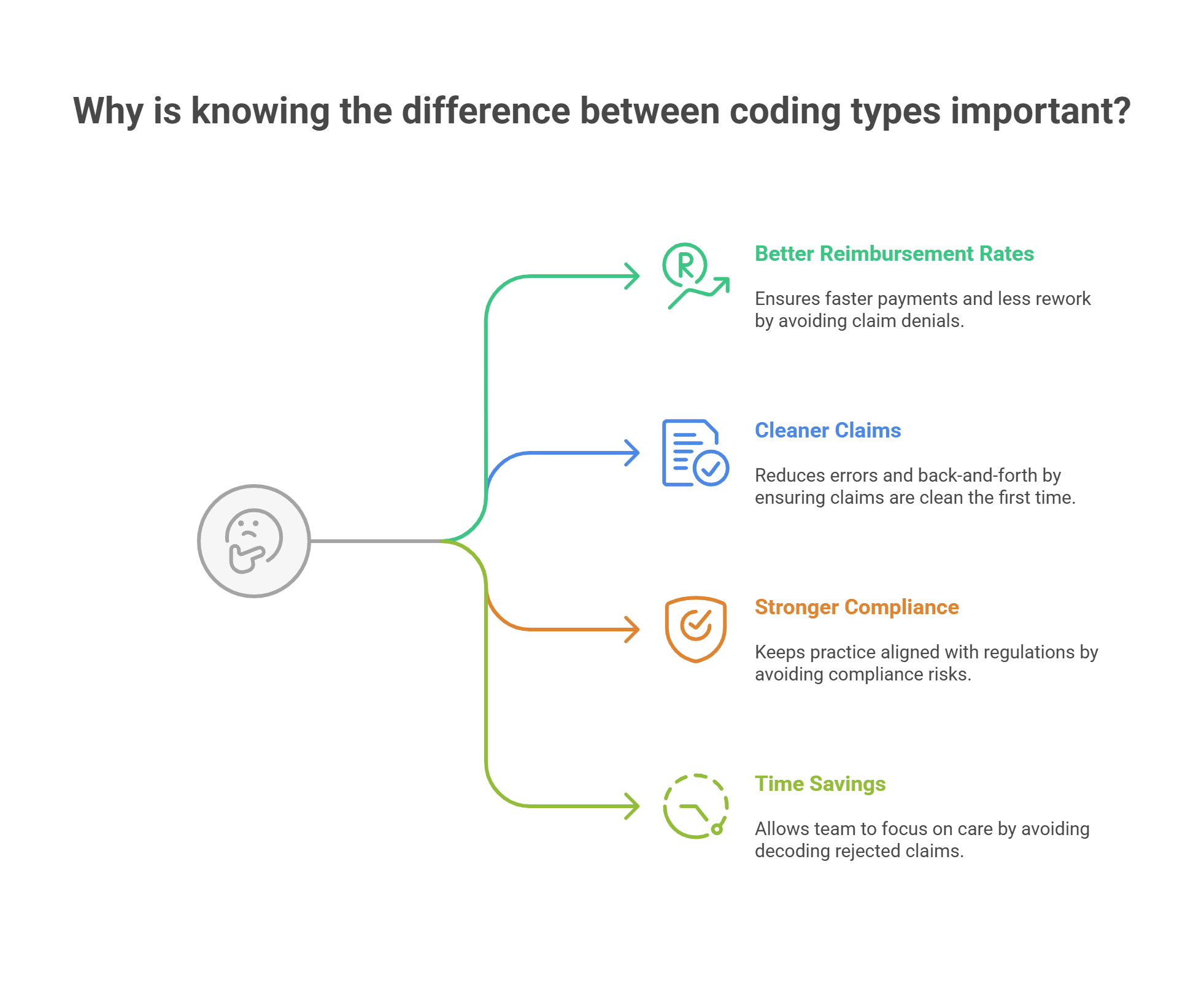On-Demand Outsourcing BPO Services for Healthcare Providers With 24/7 Coverage!
Save up to 70% on staffing costs!
Browse Specialty Staffing ServicesHow Is Outpatient Coding Different from Inpatient Coding?

But if you’re working in healthcare—especially on the admin, billing, or provider side—it’s something that can either make or break how smoothly your revenue cycle runs. So, if you’ve ever wondered, What’s the big deal between inpatient and outpatient coding? I’ve got you.
We’re not just talking definitions here—we’re getting into how it helps, why it matters, and what the real-life benefits are for you and your team.
Key Takeaways
-
Inpatient coding is used for hospital stays over 24 hours and is more detailed.
-
Outpatient coding is for same-day visits, like ER, clinics, and outpatient surgeries.
-
Each uses different code sets—ICD-10-PCS for inpatient procedures and CPT/HCPCS for outpatient.
-
Understanding the difference improves claim accuracy, reimbursement speed, and compliance.
-
Staffingly, Inc. can handle both—so your team doesn’t have to sweat the details.
Inpatient Coding: More Complex, Long-Term View
Inpatient coding is for when a patient is formally admitted to a hospital. We’re talking surgeries, post-op care, hospital stays, and everything in between. Coders use ICD-10-CM for diagnoses and ICD-10-PCS for procedures.
Common Uses:
-
Hospital stays after surgery
-
Complex treatments that require monitoring
-
Multiple-day diagnoses (e.g., stroke, heart attack)
Benefits:
✅ Captures full scope of patient care
✅ Helps hospitals track resource use
✅ Supports bundled payments and DRG-based reimbursements
✅ Enables accurate long-term care planning
Outpatient Coding: Quicker, Snapshot-Based
Outpatient coding, on the other hand, covers same-day visits—like labs, imaging, check-ups, urgent care, or outpatient procedures. Coders here use CPT/HCPCS for services and ICD-10-CM for diagnoses.
Common Uses:
-
ER visits that don’t lead to admission
-
Specialist consultations
-
Same-day surgeries or diagnostics
Benefits:
✅ Faster billing cycle
✅ More flexibility for a wide variety of encounters
✅ Easier to manage for high-volume practices
✅ Supports detailed procedure-level reimbursement

Why Knowing the Difference Actually Helps?
Let’s cut to the chase—this isn’t just trivia. Here’s how this knowledge helps your team:
1. Better Reimbursement Rates
Submitting the right type of code for the setting avoids claim denials. That means faster payments and less rework.
2. Cleaner Claims
Knowing the right code set and documentation requirements helps ensure claims are clean the first time—fewer errors, less back-and-forth.
3. Stronger Compliance
Each coding type has its own rules. Mixing them up? That’s a compliance risk you don’t want. Understanding the difference keeps your practice aligned with regulations.
4. Time Savings
Your team won’t waste time decoding rejected claims or correcting errors. Everyone can stay focused on care—not coding chaos.
How Staffingly, Inc. Can Step In
At Staffingly, Inc., our coders know inpatient and outpatient rules cold. We match each encounter with the right coding strategy, optimize for maximum reimbursement, and help your team stay compliant—without doing the heavy lifting yourself.
Whether you’re running a fast-paced urgent care or managing a full hospital department, we’ve got you covered. No hiring headaches, no training gaps—just solid, accurate coding from Day One.
What Did We Learn?
-
Inpatient = Long-term, hospital stays; uses ICD-10-PCS
-
Outpatient = Same-day visits; uses CPT/HCPCS
-
Knowing the difference = better claims, faster payments, fewer denials
-
Benefits = Compliance, cleaner data, improved patient tracking
What People Are Asking?
Q: Why are inpatient codes more complex?
A: Because they cover multiple days, services, and procedures. It’s a full picture of the patient’s hospital stay.
Q: Can I use CPT codes in inpatient settings?
A: Not for procedures. Inpatient procedures use ICD-10-PCS. CPT is for outpatient or physician services.
Q: How does Staffingly, Inc. support both?
A: We provide dedicated, trained coders who specialize in either or both, based on your organization’s needs.
Disclaimer
For informational purposes only; not applicable to specific situations.
For tailored support and professional services,
Please contact Staffingly, Inc. at (800) 489-5877
Email : support@staffingly.com.
About This Blog : This Blog is brought to you by Staffingly, Inc., a trusted name in healthcare outsourcing. The team of skilled healthcare specialists and content creators is dedicated to improving the quality and efficiency of healthcare services. The team passionate about sharing knowledge through insightful articles, blogs, and other educational resources.
 Book a Demo to Build Your Team Today!
Book a Demo to Build Your Team Today!

 Read Case Studies
Read Case Studies 



 Virtual Medical Assistants
Virtual Medical Assistants



